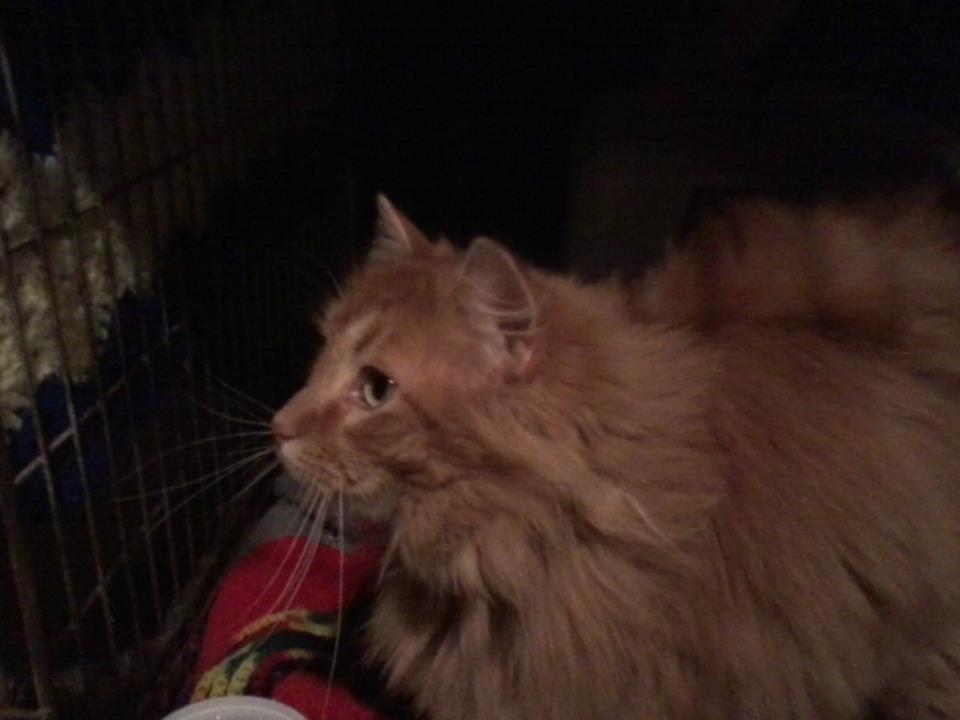Helping Feral Cats Feel More at Home
Are you interested in helping feral cats in your neighborhood by feeding them or sheltering them?
Perhaps there's a feral or homeless cat hanging around that you'd like to invite into your home?
Maybe this cat isn't so friendly, and you're unsure how to proceed?
Here's some advice from those who have done just that, and won over some furry hearts.
One of our readers, Mike Flore, asked for advice about helping a feral cat at his home. He left a comment on the home page, and to make it easy, I've re-posted it below.
He had already gotten some advice from one reader, and I have my own opinions. For example...
I'm concerned about spay/neuter and shots, the safety and health of his resident animals, and the long term future for the feral cat.
But I wanted to hear what others had to say and tap into the wisdom of the crowds. So, I reached out to readers and asked them to weigh in on the topic.
I've collected the best ideas, and put them here to help future readers so that together, we can help this cat and others.
Here's his story...
"I've become very fond of a young male feral cat that has been hanging around the house for a few months now. He even comes into the house and has a respectful arrangement with our 22 year old female cat and fourteen year old 13 lb pound pup.
I had some fear at first that there would be problems between them, but everybody seems to know how to keep the peace. He really has a good heart. He says hello, and always seems happy to see us. The interaction so far has been wonderful. We feel very fortunate that he has chosen to hang out with us.
I know that he is a wild animal, but have high hopes that he'll settle in with us. His energy is phenomenal and he brings a new life into our home. I am operating in the dark here, because I don't know what I don't know.
Can
someone share their knowledge? I really like this guy, and want to do
right by him. Thanks in advance. I don't want to own him. I just want
share our space with this wonderful creature."
Summarizing some of the commentary...
The consensus among readers is that feral cats can be tamed and even loving, but some of them will take years to come around or never come around at all.
Others will becoming loving, but somewhat untrusting pets, and there are some that will eventually act like they were never feral at all.
In general, you have to let the cat set the pace, and respect whatever level of interaction the cat wants from you. This may mean leaving the cat outside (after a health check, spay/neuter and vaccinations) for years.
Here are a few points from various contributors on winning a cat over...
Sit outside and talk with them.
No loud noises and no fast movements as ferals are skittish and need quiet.
Go slowly, use food, and don't push them too fast. Let them come to you.
Not all feral cats will let you pet them or come inside your house. With some, it takes years before they warm up to you. One reader said it took 8 years for one of the ferals in her backyard before she could pet him.
Get them checked for diseases and don't let them near your other pets right away. Get them spayed/neutered and vaccinated.
If you get the cat to come inside your house, let them hide if they want and come out in their own time.
But were these cats who have come in from the cold, so to speak, truly feral to begin with? Perhaps they were once someone's pet, but were dumped or got left behind.
Things to Consider
Should you attempt to adopt?
There's a difference between a feral cat and a stray cat. Not all homeless cats are feral.
Alley Cat Allies does not recommend adopting adult feral cats. Here's the scoop...
"Alley Cat Allies knows of committed caregivers who invest all available resources to provide indoor homes for the feral cats they manage in an attempt to tame them. It is, unfortunately, a time-consuming project with a very low rate of success. And even if a feral cat does 'tame up,' he bonds only to the caregiver who brought him in—almost never to other humans or homes.
Alley Cat Allies does not encourage attempts to adopt adult feral cats. Read on to understand why and learn better ways to help feral cats."
Read more... Trap-Neuter-Return not Trap-Neuter-Adopt
1) Decide what you want to do.
Even though it's impossible to predict what will happen, you should decide on what you want to do about this cat.
Options:
A) Leave the cat outside and provide food and water.
B) Leave the cat outside but provide some kind of shelter (garage, outdoor enclosure).
C) Bring the cat into your home on a part-time or full-time basis.
D) Get the cat to an adoptable state and have someone else adopt it.
Is the cat truly feral?
If the cat is truly feral, then A or B above may be the best options. You may also find that this cat is living in a feral colony.
If you want to bring the cat into your home or try to get someone else to adopt the cat, you're going to have to determine how people friendly the cat is, and how likely it is the cat can be integrated or adopted.
2) Protect your resident cats.
If you've got cats (or other pets) already, and you're going to bring the new cat near your existing cats, you want to make sure that...
A) Your cats do not feel displaced or threatened (there's a process for introducing a new cat), and
B) The new cat does not transfer any diseases to your cats
If the cat is truly feral, there may be a danger to your resident cats as there may be fighting. Any newcomer can put stress on your cat, but feral cats can be very unpredictable.
3) Protect the long term future of the feral cat.
Before coming into your home, the feral cat needs a health check, vaccinations, and must be spayed or neutered.
Check into local or regional (Trap Neuter Return) TNR programs to see if you can get the vet work done for free. If there isn't one, perhaps you could gather some people to start a program, starting with this cat.
If the cat is truly feral and cannot be integrated into a home, then it's usually best to return the cat to it's territory after it has been neutered and health checked.
4) Get help, involve others and raise awareness.
There are likely many cats in your area that need help, and there may be others helping ferals or strays.
Get others in the neighborhood involved, pool your resources and help each other. Get veterinarians involved (get them to volunteer their time and/or provide discounted vet care). Get teenagers and college students involved.
Use your local shelter, rescue group, or human society as a resource. Tap their personnel, volunteers, knowledge and experience.
Unfortunately, the majority of cats that are brought to shelters don't make it out. If you decide that a cat should be brought to a shelter, make sure it is a true no-kill shelter (and that they aren't fudging their numbers).
Below are ideas taken from comments made by members of our community
Give me shelter, slow moves and a pleasant voice...
Tracey Hoffmeister has 5 ferals living in her garage. They come and go through a small open window.
To give the cats protection from the cold, she made tote shelters with insulation and hay. She brings food and water out 2 times a day, in the morning and at dinner time.
At first, none of the ferals would come close to her. They would hide and wait for her to leave before eating. After almost 2 years of feeding them and talking to them, they'll come near her and some like to be petted.
Her advice is to talk to them in a low pleasant voice and move slowly... anything too fast or too loud is startling to ferals.
All of the ferals in her care have been fixed by the TNR program in her area, which is free.
Food plus patience...
Deborah Van Stone said "I have fed, fixed and tamed many feral cats. Three of them have been with me for many years and I have taken them with me on many a move. It took patience but now they all sleep on my bed."
To be able to pet them, she used a twig to get them used to being touched while they were eating wet food. With quiet and patience, they became domesticated.
Send the feral cats good vibrations...
Karin Gräfin von Kageneck said "I have a cat who not only was extremely shy but also traumatised by
mistreatment. As a meditator I always meditated near her hiding place
and after one week she approached me in meditation and never left me
again."
Feed them and treat them kindly...
Rebecca Story said a feral cat who started hanging out in her backyard became a "wonderful house cat" she named Oreo. She treated him kindly, fed him and talked to him and he eventually came around.
Have him/her neutered or spayed so s/he doesn't mark...
Cat Tales 101 said "First you need to have him/her neutered or spayed or he will start marking your house!"
"Feral are community cats, if you want to handle him feed him at the same time everyday & talk in low tones. He will eventually let you pet & handle him."
Respect the cat's need to be left alone...
Cindi Burklow said "I adopted a female feral cat and she and my other adopted male cat are best buddies. They are both about 1 1/2 and he is a real lover. She will let me pet her when I feed her canned food but not otherwise. She loves walking by me and I respect her need to be left alone. Sometimes she sleeps next to or on my leg on top of the covers. My male always sleeps with me and purrs up a storm. She never purrs but she is healthy and happy."
Lots of patience...
Karen Eplite said she had a feral male cat that stayed with her for 4 years. She set up her garage as a shelter for him because he wouldn't come inside. She got to pet him "a couple of times but that's all." She was able to capture him once after he got into a fight and get him to the vet, where he got treatment and his shots.
She also took in 3 feral babies she kept in a bedroom for a few weeks while she got her resident cats used to them. They're still skittish but she can pick them up and pet them now.
Get down on their level and speak softly...
Barb Slusark has a feral cat that she said is her buddy now and stays only indoors. But it wasn't always that way. She was able to get Skitz to trust her by getting down on her knees and speaking softly to her. She also says that you should show them that you're the one feeding them.
Never put off until tomorrow what you can do today.
Margaret Bussa said that she had rescued a pregnant female, and her advice is to rescue them sooner rather than later so that you don't have to chase down the kittens!
How are you helping feral or stray cats in your neighborhood?
Have you been able to tame one or more of these furry wild children?
If you have anything to add, please add your comment below.
Thanks in advance for your input and any advice you can offer!
More About Homeless Kitties
Cat Rescue Groups
Cat Lovers Only





Comments: What do you think?
Have your say about what you just read. Leave me a comment in the box below.